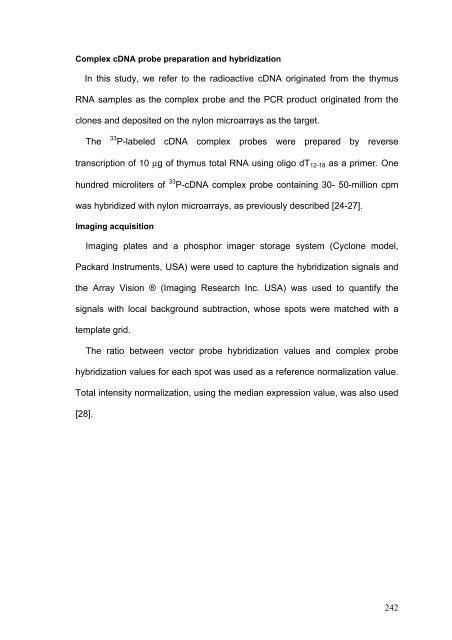O papel modulador do gene AIRE - capes
O papel modulador do gene AIRE - capes O papel modulador do gene AIRE - capes
laboratory using a Generation III Array Spotter (Amersham-MolecularDynamics, Sunnyvale, CA, USA). The complete file providing all genes presentin the microarrays used in this study is available online at(http://rge.fmrp.usp.br/passos/nylon_array/mtb1).Mouse expressed sequence tag (EST) cDNA clones were obtained from theSoares thymus 2NbMT normalized library, prepared from a C57Bl/6J 4-weekoldmale thymus, and available at the I.M.A.G.E. Consortium(http://image.llnl.gov/image/html/iresources.shtml).cDNA inserts were homogeneous in size (approximately 1 Kb) and cloned inthree vectors (pT7T3D, pBluescript and Lafmid) and were amplified in 384- or96-well plates using vector-PCR amplification with the following primers, whichrecognize the three vectors, LBP 1S 5’-GTGGAATTGTGAGCGGATACC-3’forward and LBP 1AS 5’-GCAAGGCGATTAAGTTTGG-3’ reverse.The membranes were first hybridized with the LBP 1AS[γ- 33 P]dCTP (GEHealthcare, USA) labeled oligonucleotide (vector hybridization). Quantificationof the signals obtained permitted the estimation of the amount of DNAdeposited in each spot. After stripping, the membranes were subsequently usedfor hybridization with thymus cDNA complex probes (sample hybridization).The annotation of each cDNA sequence was updated using S.O.U.R.C.E.(http://genome-www5.stanford.edu/cgi-bin/source/sourceSearch) and DAVID(http://david.abcc.ncifcrf.gov) databases, allowing for a set of information: genename, sequence, biological and molecular functions.241
Complex cDNA probe preparation and hybridizationIn this study, we refer to the radioactive cDNA originated from the thymusRNA samples as the complex probe and the PCR product originated from theclones and deposited on the nylon microarrays as the target.The33 P-labeled cDNA complex probes were prepared by reversetranscription of 10 µg of thymus total RNA using oligo dT 12-18 as a primer. Onehundred microliters of 33 P-cDNA complex probe containing 30- 50-million cpmwas hybridized with nylon microarrays, as previously described [24-27].Imaging acquisitionImaging plates and a phosphor imager storage system (Cyclone model,Packard Instruments, USA) were used to capture the hybridization signals andthe Array Vision ® (Imaging Research Inc. USA) was used to quantify thesignals with local background subtraction, whose spots were matched with atemplate grid.The ratio between vector probe hybridization values and complex probehybridization values for each spot was used as a reference normalization value.Total intensity normalization, using the median expression value, was also used[28].242
- Page 206 and 207: ANEXO IICnot10 IMAGE:576406 CCR4-NO
- Page 208 and 209: ANEXO IIEST IMAGE:576142 Expressed
- Page 210 and 211: Anexo III
- Page 212 and 213: ANEXO III197Ifit1RelaIMAGE:575632Gr
- Page 214 and 215: ANEXO III199Nde1Nol5aIMAGE:640341Rp
- Page 216 and 217: Manuscrito da Tese
- Page 218 and 219: MANUSCRITOAbstractThe expression of
- Page 220 and 221: MANUSCRITOdominated the scenario in
- Page 222 and 223: MANUSCRITOserum autoantibodies, all
- Page 224 and 225: MANUSCRITOwere transfected with 10
- Page 226 and 227: MANUSCRITOwere analyzed using the M
- Page 228 and 229: MANUSCRITOpurified from ex vivo mou
- Page 230 and 231: MANUSCRITOinformation theory as ARA
- Page 232 and 233: MANUSCRITOKyewski B, Derbinski J, G
- Page 234 and 235: MANUSCRITOBruno R, Sabater L, Tolos
- Page 236 and 237: MANUSCRITOFigure 3. The gene expres
- Page 238 and 239: MANUSCRITOABFigure 5. Genetics netw
- Page 240 and 241: SÚMULACURRICULUM VITAE (Janeiro 20
- Page 242 and 243: ESTÁGIO NO EXTERIORSÚMULA• Labo
- Page 244 and 245: SÚMULAtranscript finishing initiat
- Page 246 and 247: SÚMULAlinhagens isogênicas de cam
- Page 248 and 249: SÚMULABOLSAS DE ESTUDO• Bolsa de
- Page 250 and 251: T cell signaling gene networks duri
- Page 252 and 253: IntroductionThe thymus is an import
- Page 254 and 255: ontogeny using such technology has
- Page 258 and 259: cDNA microarray data analysisStatis
- Page 260 and 261: Gene networksAs previously mentione
- Page 262 and 263: cells, including human herpesvirus-
- Page 264 and 265: gene was mostly indirectly positive
- Page 266 and 267: lymphocytes and finally associates
- Page 268 and 269: 4) Finally, Prrg2 was also identifi
- Page 270 and 271: 14. Kishimoto H, Sprent J (2000) Th
- Page 272 and 273: proliferation of a rat astrocyte ce
- Page 274 and 275: IMMUNOLOGYORIGINAL ARTICLEOnset of
- Page 276 and 277: Promiscuous gene expression in muri
- Page 278 and 279: Promiscuous gene expression in muri
- Page 280 and 281: Promiscuous gene expression in muri
- Page 282 and 283: R.S. Cardoso et al. / Molecular Imm
- Page 284 and 285: R.S. Cardoso et al. / Molecular Imm
- Page 286 and 287: R.S. Cardoso et al. / Molecular Imm
- Page 288 and 289: R.S. Cardoso et al. / Molecular Imm
- Page 290 and 291: Molecular Immunology 42 (2005) 1043
- Page 292 and 293: D.A.R. Magalhães et al. / Molecula
- Page 294 and 295: D.A.R. Magalhães et al. / Molecula
- Page 296 and 297: Molecular and Cellular Biochemistry
- Page 298 and 299: 225Table 1. Target cDNA sequences a
- Page 300 and 301: 227coincided (CBA/J) with expressio
Complex cDNA probe preparation and hybridizationIn this study, we refer to the radioactive cDNA originated from the thymusRNA samples as the complex probe and the PCR product originated from theclones and deposited on the nylon microarrays as the target.The33 P-labeled cDNA complex probes were prepared by reversetranscription of 10 µg of thymus total RNA using oligo dT 12-18 as a primer. Onehundred microliters of 33 P-cDNA complex probe containing 30- 50-million cpmwas hybridized with nylon microarrays, as previously described [24-27].Imaging acquisitionImaging plates and a phosphor imager storage system (Cyclone model,Packard Instruments, USA) were used to capture the hybridization signals andthe Array Vision ® (Imaging Research Inc. USA) was used to quantify thesignals with local background subtraction, whose spots were matched with atemplate grid.The ratio between vector probe hybridization values and complex probehybridization values for each spot was used as a reference normalization value.Total intensity normalization, using the median expression value, was also used[28].242



